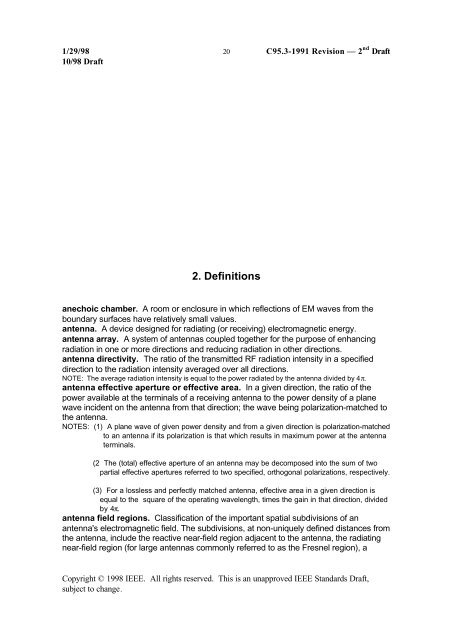DRAFT Recommended Practice for Measurements and ...
DRAFT Recommended Practice for Measurements and ...
DRAFT Recommended Practice for Measurements and ...
You also want an ePaper? Increase the reach of your titles
YUMPU automatically turns print PDFs into web optimized ePapers that Google loves.
1/29/98 20 C95.3-1991 Revision — 2 nd Draft<br />
10/98 Draft<br />
2. Definitions<br />
anechoic chamber. A room or enclosure in which reflections of EM waves from the<br />
boundary surfaces have relatively small values.<br />
antenna. A device designed <strong>for</strong> radiating (or receiving) electromagnetic energy.<br />
antenna array. A system of antennas coupled together <strong>for</strong> the purpose of enhancing<br />
radiation in one or more directions <strong>and</strong> reducing radiation in other directions.<br />
antenna directivity. The ratio of the transmitted RF radiation intensity in a specified<br />
direction to the radiation intensity averaged over all directions.<br />
NOTE: The average radiation intensity is equal to the power radiated by the antenna divided by 4π.<br />
antenna effective aperture or effective area. In a given direction, the ratio of the<br />
power available at the terminals of a receiving antenna to the power density of a plane<br />
wave incident on the antenna from that direction; the wave being polarization-matched to<br />
the antenna.<br />
NOTES: (1) A plane wave of given power density <strong>and</strong> from a given direction is polarization-matched<br />
to an antenna if its polarization is that which results in maximum power at the antenna<br />
terminals.<br />
(2 The (total) effective aperture of an antenna may be decomposed into the sum of two<br />
partial effective apertures referred to two specified, orthogonal polarizations, respectively.<br />
(3) For a lossless <strong>and</strong> perfectly matched antenna, effective area in a given direction is<br />
equal to the square of the operating wavelength, times the gain in that direction, divided<br />
by 4π.<br />
antenna field regions. Classification of the important spatial subdivisions of an<br />
antenna's electromagnetic field. The subdivisions, at non-uniquely defined distances from<br />
the antenna, include the reactive near-field region adjacent to the antenna, the radiating<br />
near-field region (<strong>for</strong> large antennas commonly referred to as the Fresnel region), a<br />
Copyright © 1998 IEEE. All rights reserved. This is an unapproved IEEE St<strong>and</strong>ards Draft,<br />
subject to change.
















